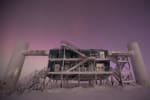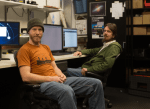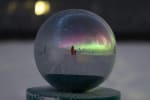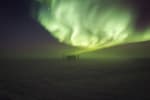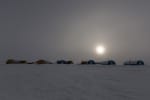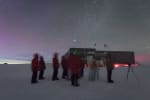This photograph of the ICL (IceCube Lab) almost looks as if it’s set against an artificial backdrop, but it is just the eerie effect of the sky lit by a rising moon. […]
Life at the Pole
An interview with the 2013-14 IceCube winterovers
Dag Larsen and Ian Rees arrived at the South Pole in November 2013. The brand-new winterovers had already been working for IceCube for a few weeks in Madison, learning all the ins and outs of their new job. Now they were ready to take over for Blaise Kuo Tiong and Felipe Pedreros, who had been at the Pole maintaining the detector for the previous 12 months. […]
Week 21 at the Pole
Some very bright auroras have been unfolding in the sky above the South Pole lately. But that doesn’t mean the only way to see an aurora is by looking upward. Here’s an aurora reflected in the metallic sphere atop the marker at the ceremonial South Pole. […]
Week 20 at the Pole
It looks like IceCube winterover Ian Rees is back to taking photographs. A good thing, too, or we wouldn’t have gotten this image of a nice aurora filling up the sky over the ICL. […]
Week 19 at the Pole
A bright moon hovers above a row of summer camp buildings at the South Pole. It’s not summer there now, of course, but with such a brightly lit sky, the winterovers may be having flashbacks to a time not so long ago when the sun shone down on this camp. They still have a way to go before the sun rises here again, with lots of photos to take in the meantime. […]
Week 18 at the Pole
What better time and place for an outdoor astronomy class than midwinter at the South Pole? Clear skies present a group of expectant gazers with a multitude of stars for their viewing pleasure. […]
Week 17 at the Pole
It helps for IceCube winterovers to be handy and versatile. With no incoming supplies during the winter months, they have to make do with what they have on hand—if they need a new tool, they craft it, or if something breaks (or rips), they fix it. […]
Week 16 at the Pole
Now there’s a flashy aurora! You know (and it’s not hard to imagine), they say a photo really can’t do justice to these aurora australis—to how impressive they really are when viewed in person. […]
Week 15 at the Pole
This is what the ICL porch looks like as it gets darker outside, bathed in red light (just two short weeks ago things looked a bit different). For the benefit of research projects that monitor the sky during winter darkness, outdoor lighting at the South Pole is minimized and kept to a red spectrum, which reduces interference. […]
Week 14 at the Pole
See anything? Well, there is something there, in this season’s first photo of an aurora from the IceCube winterovers. Many more aurora shots to come, guaranteed. […]
